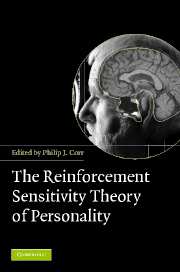Book contents
- Frontmatter
- Contents
- List of abbreviations
- List of figures
- List of tables
- List of contributors
- Preface
- 1 Reinforcement Sensitivity Theory (RST): introduction
- 2 The neuropsychology of fear and anxiety: a foundation for Reinforcement Sensitivity Theory
- 3 Animal cognition and human personality
- 4 The behavioural activation system: challenges and opportunities
- 5 Reinforcement Sensitivity Theory and personality
- 6 Reinforcement sensitivity scales
- 7 Performance and conditioning studies
- 8 Psychophysiological studies
- 9 Reinforcement Sensitivity Theory and mood induction studies
- 10 Neuro-imaging and genetics
- 11 Reinforcement Sensitivity Theory and psychosomatic medicine
- 12 RST and clinical disorders: anxiety and depression
- 13 RST and psychopathy: associations between psychopathy and the behavioral activation and inhibition systems
- 14 Behavioural activation and inhibition in social adjustment
- 15 Reinforcement sensitivity in the workplace: BIS/BAS in business
- 16 Formal and computational models of Reinforcement Sensitivity Theory
- 17 Reinforcement Sensitivity Theory: a critique from cognitive science
- 18 The contribution of Reinforcement Sensitivity Theory to personality theory
- General Index
- Index of Names
- References
10 - Neuro-imaging and genetics
Published online by Cambridge University Press: 31 January 2011
- Frontmatter
- Contents
- List of abbreviations
- List of figures
- List of tables
- List of contributors
- Preface
- 1 Reinforcement Sensitivity Theory (RST): introduction
- 2 The neuropsychology of fear and anxiety: a foundation for Reinforcement Sensitivity Theory
- 3 Animal cognition and human personality
- 4 The behavioural activation system: challenges and opportunities
- 5 Reinforcement Sensitivity Theory and personality
- 6 Reinforcement sensitivity scales
- 7 Performance and conditioning studies
- 8 Psychophysiological studies
- 9 Reinforcement Sensitivity Theory and mood induction studies
- 10 Neuro-imaging and genetics
- 11 Reinforcement Sensitivity Theory and psychosomatic medicine
- 12 RST and clinical disorders: anxiety and depression
- 13 RST and psychopathy: associations between psychopathy and the behavioral activation and inhibition systems
- 14 Behavioural activation and inhibition in social adjustment
- 15 Reinforcement sensitivity in the workplace: BIS/BAS in business
- 16 Formal and computational models of Reinforcement Sensitivity Theory
- 17 Reinforcement Sensitivity Theory: a critique from cognitive science
- 18 The contribution of Reinforcement Sensitivity Theory to personality theory
- General Index
- Index of Names
- References
Summary
Jeffrey Gray's Reinforcement Sensitivity Theory (RST) (Gray 1970, 1982) is undoubtedly one of the most influential biological oriented personality theories available. Although the theory originated from animal research it could be extrapolated on humans and allows predictions on individual differences in behaviour. Moreover, RST can be applied to understand the mechanisms underlying the continuum between normal behaviour in healthy subjects and psychopathological syndromes like depression, anxiety, impulse control disorders and drug addiction.
In his initial 1982 theory Gray postulated that the three dimensions of his RST, the Behavioural Approach System (BAS), the Behavioural Inhibition System (BIS), and the Fight-Flight System (FFS) were mainly under the control of distinct neuroanatomical structures (Gray 1982). The BAS, which is activated by conditioned signals of reward or non-punishment, was assumed to be located in limbic brain structures and to be mainly under the control of the dopaminergic (DA) system. The neuroanatomical correlate of the BIS which is activated by conditioned signals of punishment should be the subiculum and septo-hippocampal structures. The FFS was hypothesized to be sensitive to unconditioned aversive stimuli (i.e., innately painful stimuli), mediating the emotions of rage and panic – this system was thought to be related to the state of negative affect (associated with pain). The neuroanatomical basis of the FFS systems are the basolateral and centromedial nuclei of the amygdala, the ventromedial nucleus of the hypothalamus, the central gray region of the midbrain, and the somatic and motor effector nuclei of the lower brain stem.
- Type
- Chapter
- Information
- The Reinforcement Sensitivity Theory of Personality , pp. 317 - 344Publisher: Cambridge University PressPrint publication year: 2008
References
- 4
- Cited by



